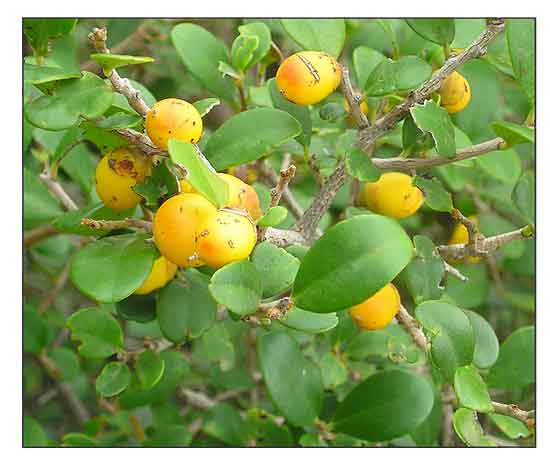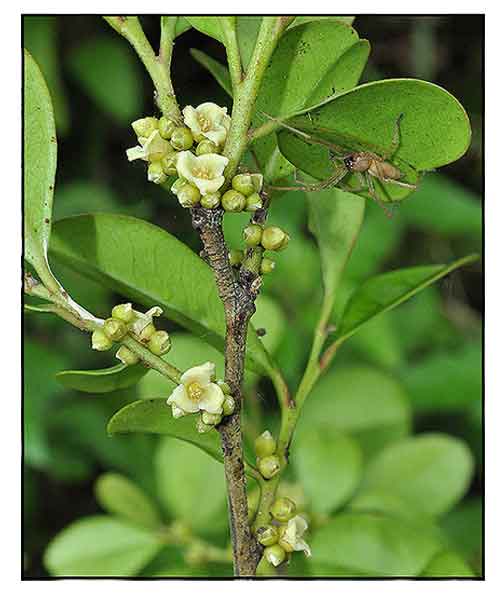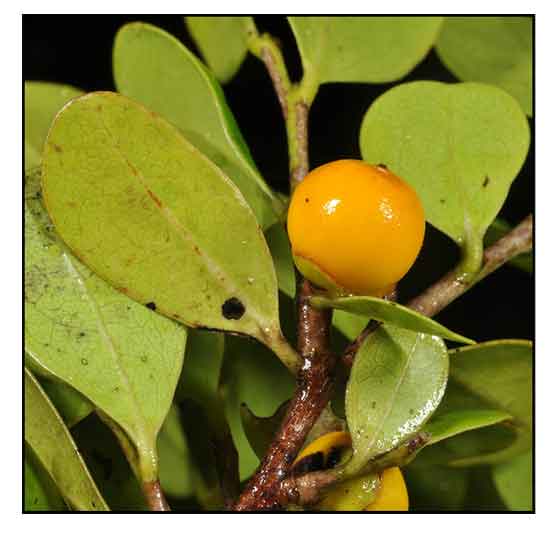 Gen info Gen info
- Diospyros is a genus of over 700 species of deciduous and evergreen trees and shrubs. The majority are native to the tropics. Individual species are valued for their hard, heavy, dark timber, commonly known as ebony trees, while some are valued for their fruit, known as persimmon trees. (16)
- The emblem of Japanese island of Ishigaki is the Yaeyama kokutan (Diospyros ferrea). (16)
- Etymology: The genus name Diospyros derives from Greek words dios (divine) and pyros (wheat), meaning divine wheat. The species epithet ferrea pertains to iron, probably referring to the color of the hard wood. (10)
Botany
Diospyros ferrea is a small, evergreen tree, sometimes procumbent. Branchlets grayish, pubescent to hirsute, glabrescent. Winter buds appressed brownish pubescent to hirsute. Petiole 4--5 mm; leaf blade oblong, oblong-oblanceolate, or elliptic, occasionally obovate, 2--4(--8) X 1--2(--3) cm, leathery, glabrous or nearly so, base attenuate to obtuse, apex rounded to emarginate, lateral veins 5--7 per side and usually inconspicuous, reticulate veinlets almost invisible and sometime adaxially ± raised. Male inflorescences 1--3-flowered, densely appressed pubescent; pedicel very short to almost absent; calyx cup-shaped, 2.5--3.5 mm, densely pubescent; calyx lobes 3, erect, flat, ca. 1/2 as long as tube, apex rounded; corolla urn-shaped, 6--8.5 mm; corolla tube 4--5 mm, outside partly densely sericeous, inside glabrous; corolla lobes 3, spreading, 2--3.5 X 1.5--2 mm, apex rounded; stamens (5--)8, often partly exserted from tube; pistillode densely hirsute. Female flowers sessile or subsessile; calyx lobes 3--5, ciliate, outside tomentose; ovary 3-locular, densely hirsute, rarely glabrescent. Fruit solitary, subsessile. Fruiting calyx bowl-shaped, ca. 3 X 6 mm, pubescent or glabrous; lobes 3(--5), shorter than tube, apex rounded. Berries ellipsoid, 8--13 X ca. 8 mm, 3-locular, finely puberulous, glabrous when mature. Seeds 1--3, almost black, cylindric, often flat on one side, ca. 8 X 3.5 mm. (Flora of China)
Distribution
- Native to the Philippines.
- Also native to Angola, Bangladesh, Benin, Borneo, Burkina, Cambodia, Cameroon, Central African Repu, Gabon, Ghana, Guinea, Guinea-Bissau, Gulf of Guinea Is., India, Ivory Coast, Jawa, Kenya, Laos, Lesser Sunda Is., Liberia, Madagascar, Malaya, Mali, Maluku, Mozambique, Myanmar, Nansei-shoto, New Guinea, Nigeria, Santa Cruz Is., Senegal, Sierra Leone, Solomon Is., Sri Lanka, Sudan, Sulawesi, Sumatera, Taiwan, Tanzania, Thailand, Vanuatu, Vietnam, Zaïre, Zimbabwe. (1)
- Native range is Tropical Africa to SW Pacific. It grows primariy in the seasonally dry tropical biome. (1)
 Constituents Constituents
- Qualitative phytochemical analysis of methanol (M) and ethanol (E) root extracts yielded carbohydrates ++ ME, tannin ++M+E, flavonoid ++ME, alkaloid ++ME, quinones +M++E, cardiac glycosides -ME++E, terpenoid +M++E, triterpenoids +M++E, phenols +M++E, proteins +ME, steroids +M++E, phytosterols +ME, with absence of saponin, glycosides, coumarins, acids, anthraquinones, phlobatannins. (11)
- Preliminary phytochemical analysis of hexane leaf extract revealed presence of alkaloids, phlobatannins, glycosides, flavonoids, phenols, saponins, and terpenoids. Ethyl acetate extract yielded glycosides, flavonoids, and terpenoids. Methanol leaf extracts yielded tannins, glycosides, and saponins. (15)
- GC-MS study of solvent extracts of leaves yielded 40 phytocompounds. Seventeen compounds were identified from a methanolic leaf extract, 16 from the ethyl acetate solvent, and seven from the hexane solvent. Phytol, friedelan-3-one, squalene, tocopherol, α-amyrin, betulin, citronellol, pregnenolene, olen and thunbergol were important phytoconstituents identified from leaf extracts, grouped under hydrocarbons, terpenes and phenolic compounds. (15)
Properties
- Studies have suggested antioxidant, analgesic, anti-inflammatory, antidiabetic, antimicrobial, anticancer, fibrinolytic properties.
Parts used
Fruits, leaves, roots.
 Uses Uses
Edibility
- Fruits pulp is edible when ripe. Reported to be a famine food in southern India. (2)
Folkloric
- No reported folkloric medicinal use in the Philippines.
- In Irulas tradition medicine in India, used to treat blood circulation problems. (7)
- In India, fruits used for the treatment of diarrhea, internal bleeding, kidney stones, sore throats. (12)
Others
- Wood: Heartwood is jet black, with whitish or grayish streaks when streaky. Wood is close-grained, very hard, dense, durable, and liable to split.
- Crafts: Wood used for ornamental carvings, walking sticks, cabinet work, boat-anchors, tool handles, weapon sheaths and rafters. Heartwood used for scabbards, gunstocks, sawframes, finger boards for musical instruments, inlaying, paper weights, etc. Sapwood, almost as hard as heartwood, makes excellent material for T-squares, drawing instruments, bobbins, spindles, golf-club heads and shafts, axe and hammer handles, etc.
(3)
- Cordage: Fibrous bark used to making cordage. (3)
Studies
• Silver Nanoparticles / Antioxidant / Anti-Inflammatory / Antimicrobial / Anticancer / Leaves: Study reports on the synthesis of silver nanoparticles using D. ferrea leaves. The AgNPs showed antioxidant potential with IC50 of 227.58 µg/ml for free radical scavenging activity. Antimicrobial activity was assessed against S. aureus, M. luteus, E. coli, K. pneumonia, A. flavus and A. fumigatus Anti-inflammatory potential was assessed by albumin denaturation assay with maximum inhibition of 65,21% at 100 µg/mL and IC50 of 76.67 µg/mL. Anticancer activity using MCF-7 and HepG2 cell lines showed IC50s of 71.41 and 59.59 µg/mL, respectively. Results showed the AgNPs have significant antioxidant, antimicrobial, anti-inflammatory and antiproliferative activity. (4)
• Gallic Acid Profile / Roots: Gallic acid is a polyhydroxyphenolic compound widely distributed in various plants, fruits, and foods. GA and its derivates are strong antioxidants able to scavenge reactive oxygen species, with a number of biological and pharmaceutical activities. Study reports on the HPTLC gallic acid profile of D. ferrea. Higher degree of gallic acid diversity was observed in vegetative parts of roots, with gallic acid Rf value of 0.46, 0.47 in D. ferrea. Average recovery of gallic acid was 47.50 µg/ml. The proposed HPTLC method provide a good resolution of gallic acid from other constituents present in the ethanolic root extract. (5)
• Anti-Inflammatory / Analgesic / Roots: Chloroform and methanolic extracts of roots (100-200 mg/kg) were tested for anti-inflammatory and analgesic activity in wistar albino rats. The extracts exhibited 37% reduction in inflammation when compared to ibuprofen using carrageenan induced rat paw edema method and significant analgesic activity using tail-flick method. (6)
• Antidiabetic / Regeneration of Pancreatic Cells / Leaves: Study evaluated the histopathological effect of daily administration of methanolic leaf extract (200 and 400 mg/kbw) in streptozotocin-induced diabetic rats. The 400 mg/kbw dose showed significant repair of hepatic acini and pancreatic islets in diabetic rats. The liver tissue of diabetic rat exhibited foci of inflammation and necrosis of cells and cystic degeneration of islet cells along with periductular fibrosis in pancreatic tissue. Leaf extract treatment resulted in regeneration of normal liver cells and islet cells in pancreas. Effects were comparable with antidiabetic effects of glibenclamide and statistically significant when compared to control. (7) Study evaluated a methanolic extract of leaves for antidiabetic activity in STZ-induced diabetic rats for 21 days. At dose of 400 mg/kg, the leaf extract exhibited beneficial effects of various parameters viz., blood glucose, serum lipid profile, serum protein, serum urea, uric acid, creatinine, glycosylated hemoglobin, liver glycogen, liver antioxidant enzymes and serum ALT and AST levels. (13)
• Antioxidant / Antimicrobial / Bark: Study evaluated the antioxidant and antimicrobial properties of various D. ferrea bark extracts. A methanol extract showed highest phenol content and the aqueous extract showed highest flavonoid content. The ME and AE showed effective antimicrobial activity against bacterial and fungal strains. The ME showed dose-dependent DPPH radical scavenging activity. The ME showed 77.77% reduction of phosphomolybdenum reduction activity at 300 µg/mL, maximum inhibition of nitric oxide radical scavenging, and highest Fe3+ reducing power activity. (9)
• Fibrinolytic / Antioxidant / Stem: Study evaluated the fibrinolytic and antioxidant activity of methanol extract of Maba buxifolia stem. A methanol extract showed highest fibrinolytic activity with maximum 24.3% clot lysis and antioxidant potential equivalent to ascorbic acid. (12)
Availability
Wild-crafted.
Seeds in the cybermarket.
|

![]()



 Gen info
Gen info

